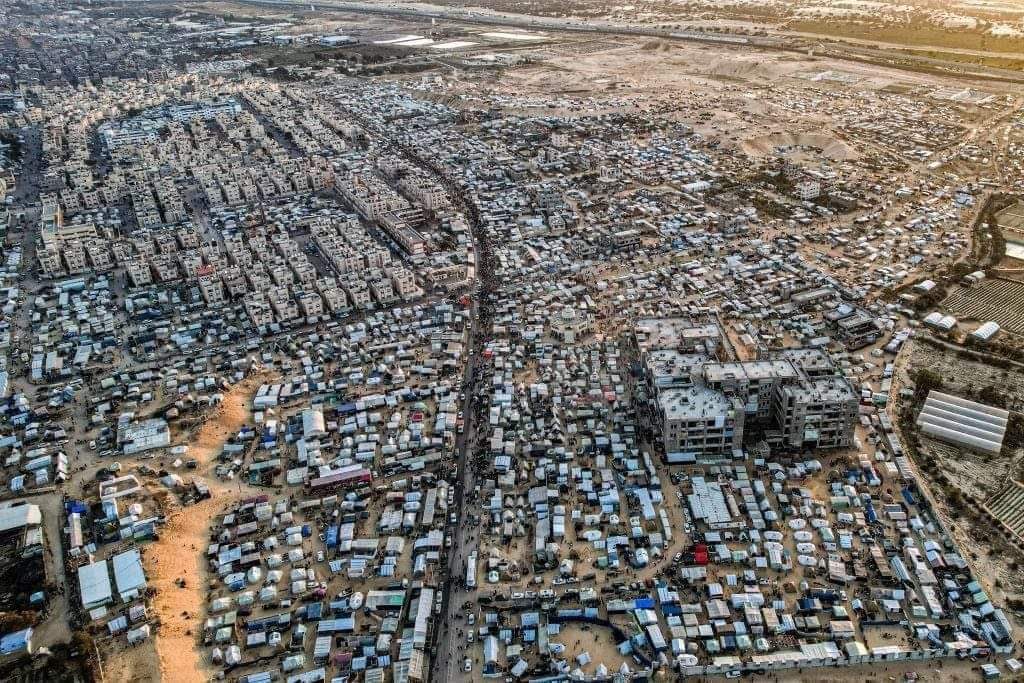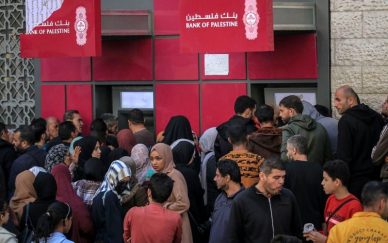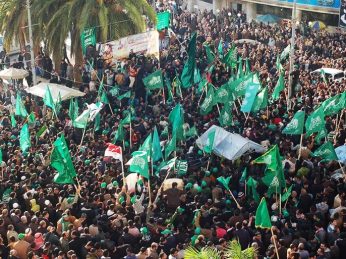GAZA, (PIC)
The Israeli government continues to threaten from time to time a large-scale ground invasion of the Palestinian city of Rafah, located in the southern part of the Gaza Strip. They claim that Rafah is the last stronghold of Palestinian resistance, hoping to achieve a superficial victory that could save premier Netanyahu and his government from accountability after its failure in the Al-Aqsa flood battle on October 7th last year.
More than one and a half million displaced people are crowded in the city of Rafah after being forcibly displaced from the rest of the cities in the Gaza Strip, due to the genocidal crimes committed by the Israeli occupation forces against them, sparing no one or anything in deliberately killing and destroying all aspects of life there.
The United Nations warns of a catastrophic situation in the city of Rafah if Israel carries out its threat to militarily invade the city, citing immense pressure on its institutions to develop a plan aimed at assisting the displaced people in the city. Nonetheless, Israel is preparing to launch a large-scale military operation in Rafah.
Doctors and relief workers are struggling to provide basic aid and prevent the spread of diseases among the displaced people.
Why Rafah?
With the start of the brutal Israeli aggression on Gaza following the Al-Aqsa flood operation, the major targeting was on the northern cities, where Israel did not leave their residents a chance to live, even in UN shelters and displacement centers. This forced the people of the northern and central cities to flee towards the south. The situation became more difficult after intensifying the shelling and aggression on the south, specifically in the city of Khan Yunis. The Gaza residents found no refuge except in the border city of Rafah.
Rafah is located in the southern tip of the Gaza Strip, on the border strip separating it from the Egyptian Sinai Peninsula. It is the largest city in the Gaza Strip on the Egyptian border, covering an area of 55 square kilometers. The only border crossing with Egypt is in Rafah, which is the main gateway for delivering aid to Gaza and for the transportation of the injured for treatment and travel out of the enclave.
Over the past decades, dozens of tunnels extended unofficially across the borders between Gaza and Egypt, until the Egyptian army demolished them in recent years and erected barriers to prevent infiltration to and from Gaza, according to Egyptian authorities’ estimates.
Western reports estimate that the tunnel network in Gaza extends between 500 and 700 kilometers beneath all cities in the Strip. Despite the measures taken by the Egyptian authorities to prevent communication between their country and Gaza, it is still unknown whether these tunnels still exist or not. However, it is certain that hundreds of trucks enter the Strip daily through the Rafah crossing, under normal circumstances before the war.
Historical Background
Rafah came under British rule in 1917, and in 1948, the Egyptian army entered Rafah, and it came under Egyptian control until it fell into the hands of Israel in 1956. It returned to Egyptian administration in 1957 until 1967 when it was occupied by Israel.
Following the Camp David Accords, Rafah was divided into two halves by barbed wire fences. Egypt regained control of the Sinai Peninsula, and as a result, Rafah Sinai became separate from Rafah Gaza. The area of the section located in Gaza is approximately three times the size of the section located in Egypt.
On a human level, most of the residents of Rafah trace their origins back to the city of Khan Yunis, as well as the Bedouins of the Negev Desert and the Sinai Desert. They were later joined by Palestinian refugees who came from various villages and cities to Rafah after the Nakba in 1948.
Crisis of the Displaced
With the displacement of over one and a half million people from the provinces and cities of the Gaza Strip, the population of Rafah has multiplied fivefold. They live in difficult conditions in overcrowded shelters like schools, on the streets, or in any available open space, surrounded by the Egyptian and Israeli border fences and the Mediterranean Sea, in addition to facing Israeli shelling.
The city also suffers from a healthcare crisis, with only a few hospitals such as Rafah Central Hospital, Kuwait Specialized Hospital, and Martyr Abu Yousef Al-Najjar Hospital. These hospitals face shortages of medical supplies, electricity, and energy sources, which affect the ability of doctors and medical teams to provide treatment and care for patients.
Relief agencies state that they cannot relocate people to safer areas because Israeli forces are concentrated in the north, and the aid allowed to enter the Gaza Strip is extremely limited.
The displaced people live in makeshift tents constructed from metal bars, sticks, or tree branches, covered with fabrics or plastic materials. Thousands of tents have been erected in Rafah since early December, near the Egyptian border, covering an area of approximately 3.5 square kilometers.
Many of the displaced people prefer to stay in the western part of the city, close to the sea, out of fear of being invaded from the eastern side near the Israeli border.
Displacement or Return
The attention of the displaced people, as well as the entire world, is focused on the outcome of the Cairo talks aimed at reaching a ceasefire agreement. Israel remains obstinate in achieving calm conditions while continuing its war on the Palestinian people in Gaza, while the resistance affirms its openness to all proposals that lead to an end to the aggression and the withdrawal of Israeli forces from all Gaza territories.
This remains the last hope for the residents and displaced people of Rafah, who await a decision that will return them to their homes. They fear a decision that will push them towards further migration and an unknown fate, uncertain of when or where it will end, and whether they will endure another limitless catastrophe or if fate will spare them from what they fear.















